92318 Evidence for Nursing: Assessment 3 Submission Template - 2019
VerifiedAdded on 2023/04/25
|12
|5464
|490
Homework Assignment
AI Summary
This assessment focuses on evidence-based practice within a nursing context. It begins with the formulation of a focused research question using the PICO framework (Patient/Problem, Intervention, Comparison, Outcome). The assignment then involves developing a search strategy, including alternative search terms, and applying it to two different databases, with screenshots of the search process. Students are required to select and include the abstract of a relevant randomized controlled trial (RCT) and a qualitative study. A significant portion of the assessment involves appraising the quality of the selected RCT using the CASP tool, critically evaluating its validity, results, and applicability. The document includes sections for justifying answers to appraisal questions. The assignment emphasizes the importance of understanding and applying research evidence to inform clinical practice, including the use of screenshots and abstracts to demonstrate understanding of the search and appraisal process. It is a comprehensive evaluation of a student's ability to find, evaluate, and apply research evidence within the field of nursing.
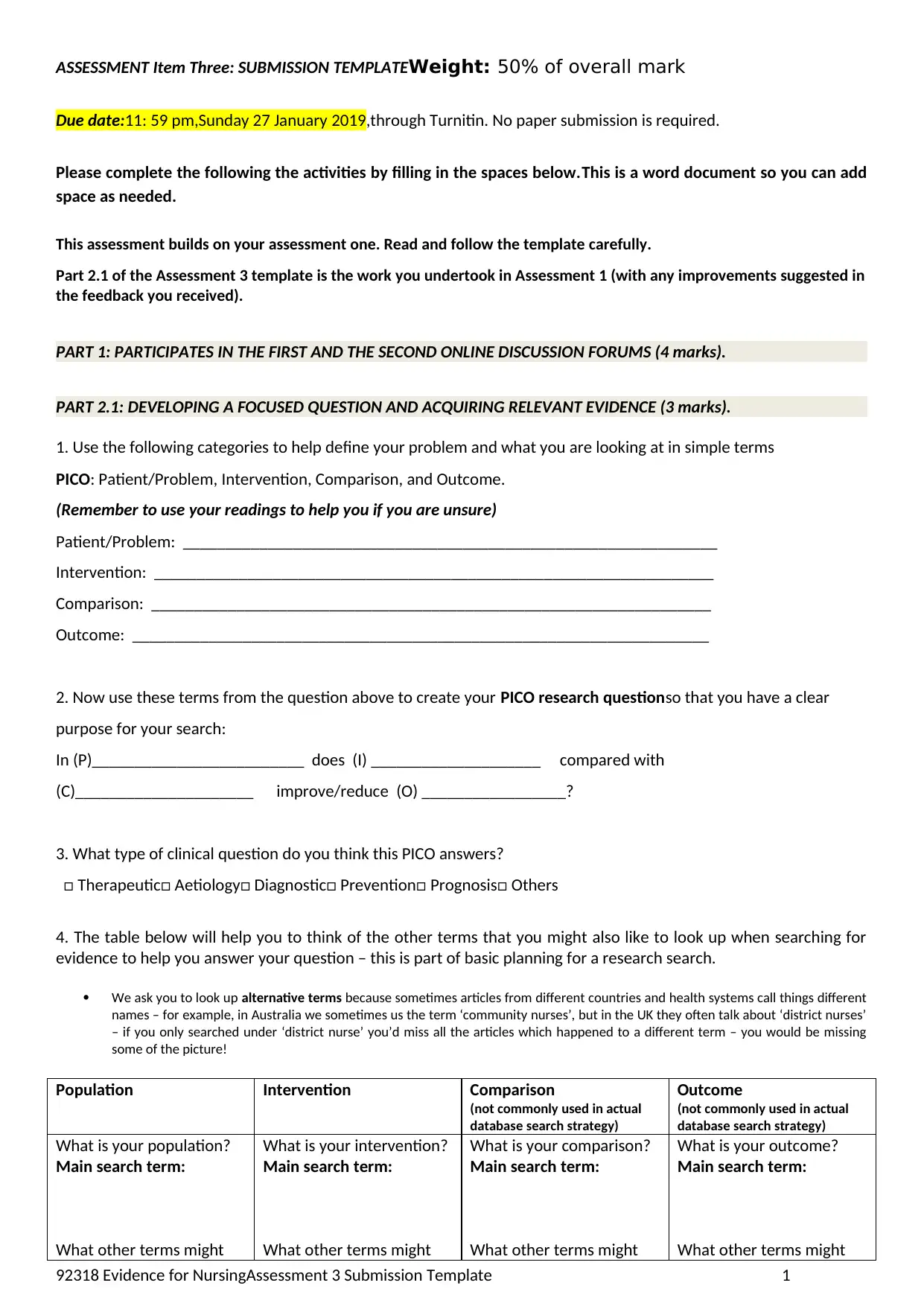
ASSESSMENT Item Three: SUBMISSION TEMPLATEWeight: 50% of overall mark
Due date:11: 59 pm,Sunday 27 January 2019,through Turnitin. No paper submission is required.
Please complete the following the activities by filling in the spaces below.This is a word document so you can add
space as needed.
This assessment builds on your assessment one. Read and follow the template carefully.
Part 2.1 of the Assessment 3 template is the work you undertook in Assessment 1 (with any improvements suggested in
the feedback you received).
PART 1: PARTICIPATES IN THE FIRST AND THE SECOND ONLINE DISCUSSION FORUMS (4 marks).
PART 2.1: DEVELOPING A FOCUSED QUESTION AND ACQUIRING RELEVANT EVIDENCE (3 marks).
1. Use the following categories to help define your problem and what you are looking at in simple terms
PICO: Patient/Problem, Intervention, Comparison, and Outcome.
(Remember to use your readings to help you if you are unsure)
Patient/Problem: _______________________________________________________________
Intervention: __________________________________________________________________
Comparison: __________________________________________________________________
Outcome: ____________________________________________________________________
2. Now use these terms from the question above to create your PICO research questionso that you have a clear
purpose for your search:
In (P)_________________________ does (I) ____________________ compared with
(C)_____________________ improve/reduce (O) _________________?
3. What type of clinical question do you think this PICO answers?
□ Therapeutic□ Aetiology□ Diagnostic□ Prevention□ Prognosis□ Others
4. The table below will help you to think of the other terms that you might also like to look up when searching for
evidence to help you answer your question – this is part of basic planning for a research search.
We ask you to look up alternative terms because sometimes articles from different countries and health systems call things different
names – for example, in Australia we sometimes us the term ‘community nurses’, but in the UK they often talk about ‘district nurses’
– if you only searched under ‘district nurse’ you’d miss all the articles which happened to a different term – you would be missing
some of the picture!
Population Intervention Comparison
(not commonly used in actual
database search strategy)
Outcome
(not commonly used in actual
database search strategy)
What is your population?
Main search term:
What other terms might
What is your intervention?
Main search term:
What other terms might
What is your comparison?
Main search term:
What other terms might
What is your outcome?
Main search term:
What other terms might
92318 Evidence for NursingAssessment 3 Submission Template 1
Due date:11: 59 pm,Sunday 27 January 2019,through Turnitin. No paper submission is required.
Please complete the following the activities by filling in the spaces below.This is a word document so you can add
space as needed.
This assessment builds on your assessment one. Read and follow the template carefully.
Part 2.1 of the Assessment 3 template is the work you undertook in Assessment 1 (with any improvements suggested in
the feedback you received).
PART 1: PARTICIPATES IN THE FIRST AND THE SECOND ONLINE DISCUSSION FORUMS (4 marks).
PART 2.1: DEVELOPING A FOCUSED QUESTION AND ACQUIRING RELEVANT EVIDENCE (3 marks).
1. Use the following categories to help define your problem and what you are looking at in simple terms
PICO: Patient/Problem, Intervention, Comparison, and Outcome.
(Remember to use your readings to help you if you are unsure)
Patient/Problem: _______________________________________________________________
Intervention: __________________________________________________________________
Comparison: __________________________________________________________________
Outcome: ____________________________________________________________________
2. Now use these terms from the question above to create your PICO research questionso that you have a clear
purpose for your search:
In (P)_________________________ does (I) ____________________ compared with
(C)_____________________ improve/reduce (O) _________________?
3. What type of clinical question do you think this PICO answers?
□ Therapeutic□ Aetiology□ Diagnostic□ Prevention□ Prognosis□ Others
4. The table below will help you to think of the other terms that you might also like to look up when searching for
evidence to help you answer your question – this is part of basic planning for a research search.
We ask you to look up alternative terms because sometimes articles from different countries and health systems call things different
names – for example, in Australia we sometimes us the term ‘community nurses’, but in the UK they often talk about ‘district nurses’
– if you only searched under ‘district nurse’ you’d miss all the articles which happened to a different term – you would be missing
some of the picture!
Population Intervention Comparison
(not commonly used in actual
database search strategy)
Outcome
(not commonly used in actual
database search strategy)
What is your population?
Main search term:
What other terms might
What is your intervention?
Main search term:
What other terms might
What is your comparison?
Main search term:
What other terms might
What is your outcome?
Main search term:
What other terms might
92318 Evidence for NursingAssessment 3 Submission Template 1
Paraphrase This Document
Need a fresh take? Get an instant paraphrase of this document with our AI Paraphraser
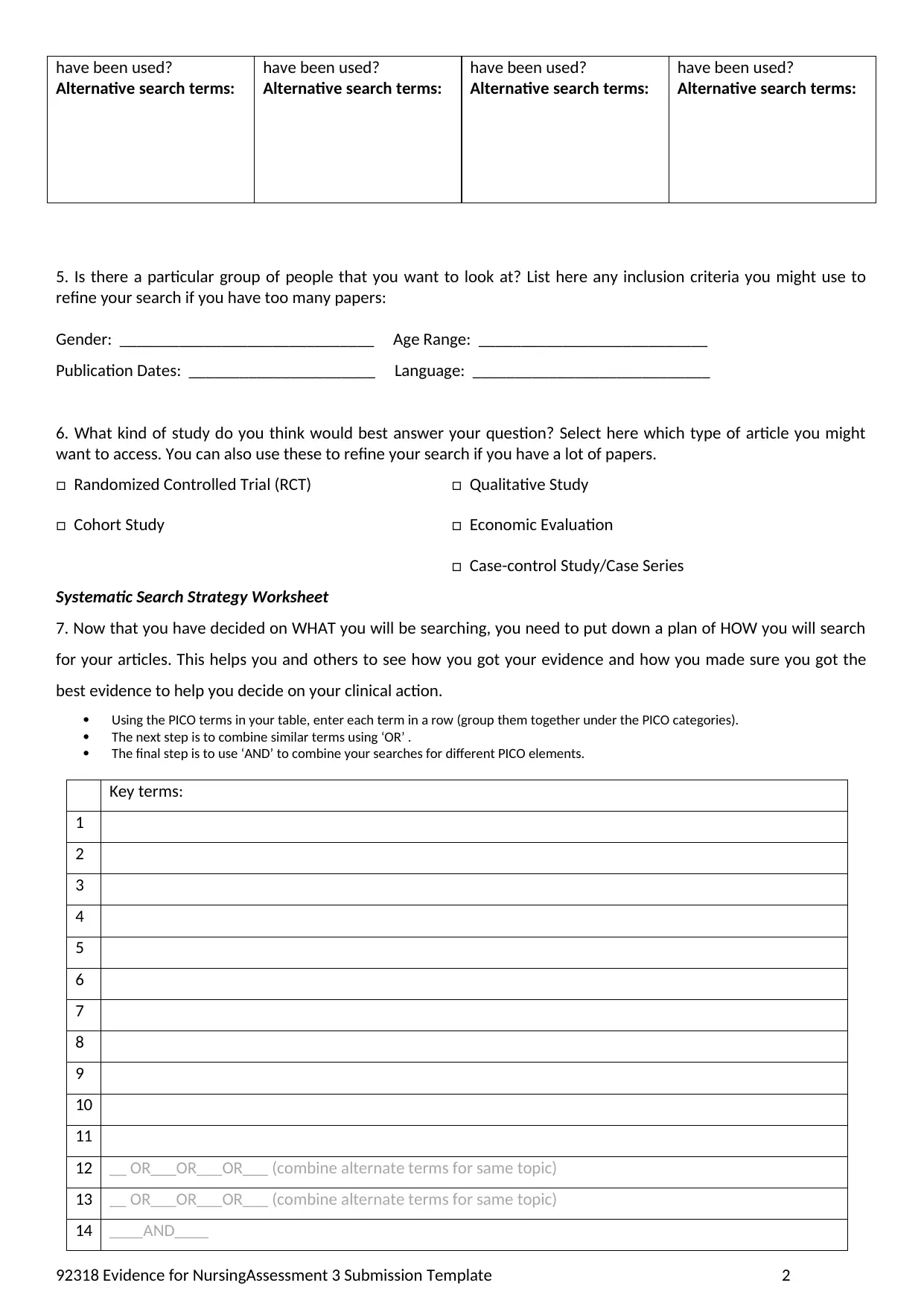
have been used?
Alternative search terms:
have been used?
Alternative search terms:
have been used?
Alternative search terms:
have been used?
Alternative search terms:
5. Is there a particular group of people that you want to look at? List here any inclusion criteria you might use to
refine your search if you have too many papers:
Gender: ______________________________ Age Range: ___________________________
Publication Dates: ______________________ Language: ____________________________
6. What kind of study do you think would best answer your question? Select here which type of article you might
want to access. You can also use these to refine your search if you have a lot of papers.
□ Randomized Controlled Trial (RCT)
□ Cohort Study
□ Qualitative Study
□ Economic Evaluation
□ Case-control Study/Case Series
Systematic Search Strategy Worksheet
7. Now that you have decided on WHAT you will be searching, you need to put down a plan of HOW you will search
for your articles. This helps you and others to see how you got your evidence and how you made sure you got the
best evidence to help you decide on your clinical action.
Using the PICO terms in your table, enter each term in a row (group them together under the PICO categories).
The next step is to combine similar terms using ‘OR’ .
The final step is to use ‘AND’ to combine your searches for different PICO elements.
Key terms:
1
2
3
4
5
6
7
8
9
10
11
12 __ OR___OR___OR___ (combine alternate terms for same topic)
13 __ OR___OR___OR___ (combine alternate terms for same topic)
14 ____AND____
92318 Evidence for NursingAssessment 3 Submission Template 2
Alternative search terms:
have been used?
Alternative search terms:
have been used?
Alternative search terms:
have been used?
Alternative search terms:
5. Is there a particular group of people that you want to look at? List here any inclusion criteria you might use to
refine your search if you have too many papers:
Gender: ______________________________ Age Range: ___________________________
Publication Dates: ______________________ Language: ____________________________
6. What kind of study do you think would best answer your question? Select here which type of article you might
want to access. You can also use these to refine your search if you have a lot of papers.
□ Randomized Controlled Trial (RCT)
□ Cohort Study
□ Qualitative Study
□ Economic Evaluation
□ Case-control Study/Case Series
Systematic Search Strategy Worksheet
7. Now that you have decided on WHAT you will be searching, you need to put down a plan of HOW you will search
for your articles. This helps you and others to see how you got your evidence and how you made sure you got the
best evidence to help you decide on your clinical action.
Using the PICO terms in your table, enter each term in a row (group them together under the PICO categories).
The next step is to combine similar terms using ‘OR’ .
The final step is to use ‘AND’ to combine your searches for different PICO elements.
Key terms:
1
2
3
4
5
6
7
8
9
10
11
12 __ OR___OR___OR___ (combine alternate terms for same topic)
13 __ OR___OR___OR___ (combine alternate terms for same topic)
14 ____AND____
92318 Evidence for NursingAssessment 3 Submission Template 2
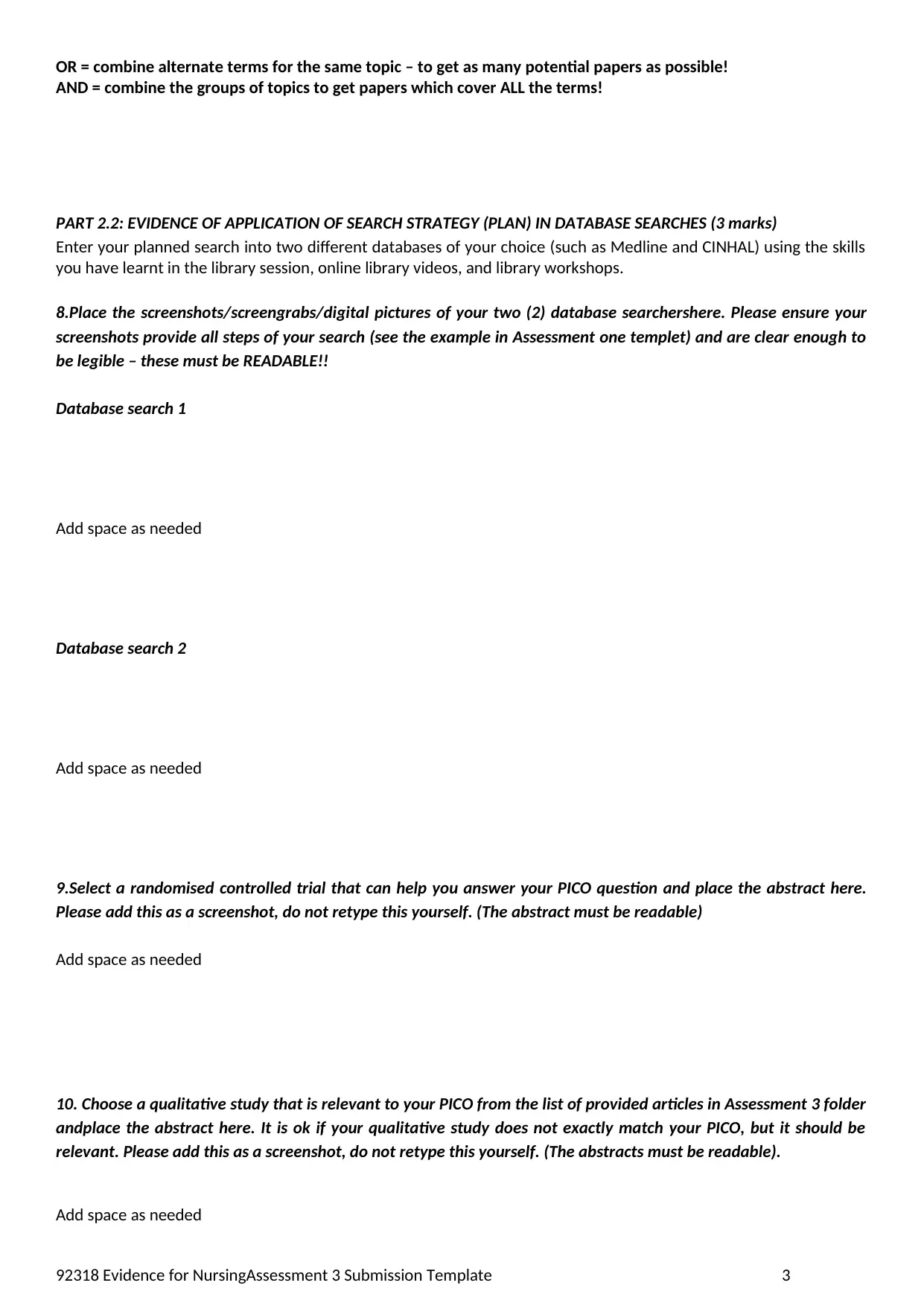
OR = combine alternate terms for the same topic – to get as many potential papers as possible!
AND = combine the groups of topics to get papers which cover ALL the terms!
PART 2.2: EVIDENCE OF APPLICATION OF SEARCH STRATEGY (PLAN) IN DATABASE SEARCHES (3 marks)
Enter your planned search into two different databases of your choice (such as Medline and CINHAL) using the skills
you have learnt in the library session, online library videos, and library workshops.
8.Place the screenshots/screengrabs/digital pictures of your two (2) database searchershere. Please ensure your
screenshots provide all steps of your search (see the example in Assessment one templet) and are clear enough to
be legible – these must be READABLE!!
Database search 1
Add space as needed
Database search 2
Add space as needed
9.Select a randomised controlled trial that can help you answer your PICO question and place the abstract here.
Please add this as a screenshot, do not retype this yourself. (The abstract must be readable)
Add space as needed
10. Choose a qualitative study that is relevant to your PICO from the list of provided articles in Assessment 3 folder
andplace the abstract here. It is ok if your qualitative study does not exactly match your PICO, but it should be
relevant. Please add this as a screenshot, do not retype this yourself. (The abstracts must be readable).
Add space as needed
92318 Evidence for NursingAssessment 3 Submission Template 3
AND = combine the groups of topics to get papers which cover ALL the terms!
PART 2.2: EVIDENCE OF APPLICATION OF SEARCH STRATEGY (PLAN) IN DATABASE SEARCHES (3 marks)
Enter your planned search into two different databases of your choice (such as Medline and CINHAL) using the skills
you have learnt in the library session, online library videos, and library workshops.
8.Place the screenshots/screengrabs/digital pictures of your two (2) database searchershere. Please ensure your
screenshots provide all steps of your search (see the example in Assessment one templet) and are clear enough to
be legible – these must be READABLE!!
Database search 1
Add space as needed
Database search 2
Add space as needed
9.Select a randomised controlled trial that can help you answer your PICO question and place the abstract here.
Please add this as a screenshot, do not retype this yourself. (The abstract must be readable)
Add space as needed
10. Choose a qualitative study that is relevant to your PICO from the list of provided articles in Assessment 3 folder
andplace the abstract here. It is ok if your qualitative study does not exactly match your PICO, but it should be
relevant. Please add this as a screenshot, do not retype this yourself. (The abstracts must be readable).
Add space as needed
92318 Evidence for NursingAssessment 3 Submission Template 3
⊘ This is a preview!⊘
Do you want full access?
Subscribe today to unlock all pages.

Trusted by 1+ million students worldwide
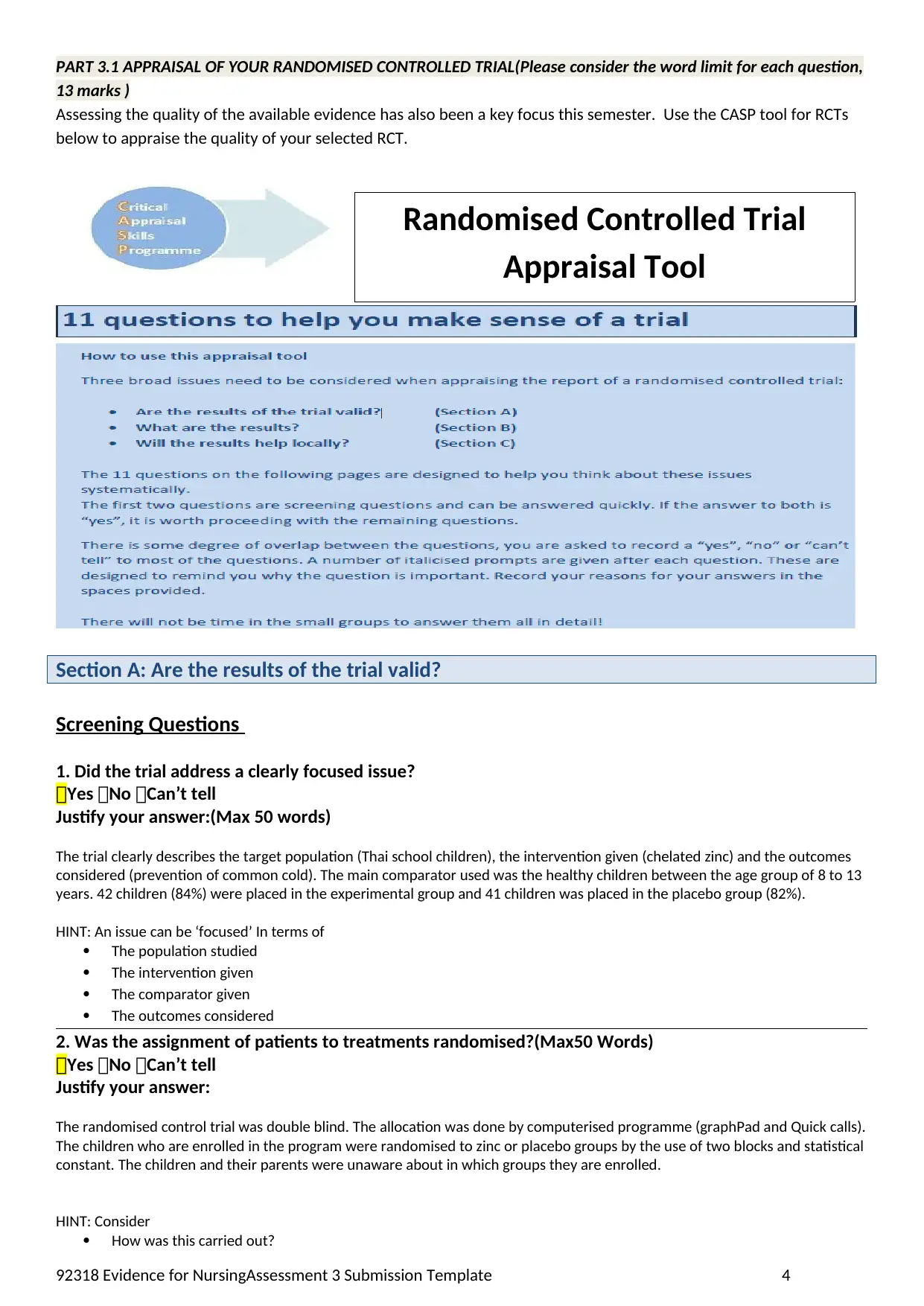
PART 3.1 APPRAISAL OF YOUR RANDOMISED CONTROLLED TRIAL(Please consider the word limit for each question,
13 marks )
Assessing the quality of the available evidence has also been a key focus this semester. Use the CASP tool for RCTs
below to appraise the quality of your selected RCT.
Section A: Are the results of the trial valid?
Screening Questions
1. Did the trial address a clearly focused issue?
Yes No Can’t tell
Justify your answer:(Max 50 words)
The trial clearly describes the target population (Thai school children), the intervention given (chelated zinc) and the outcomes
considered (prevention of common cold). The main comparator used was the healthy children between the age group of 8 to 13
years. 42 children (84%) were placed in the experimental group and 41 children was placed in the placebo group (82%).
HINT: An issue can be ‘focused’ In terms of
The population studied
The intervention given
The comparator given
The outcomes considered
2. Was the assignment of patients to treatments randomised?(Max50 Words)
Yes No Can’t tell
Justify your answer:
The randomised control trial was double blind. The allocation was done by computerised programme (graphPad and Quick calls).
The children who are enrolled in the program were randomised to zinc or placebo groups by the use of two blocks and statistical
constant. The children and their parents were unaware about in which groups they are enrolled.
HINT: Consider
How was this carried out?
92318 Evidence for NursingAssessment 3 Submission Template 4
Randomised Controlled Trial
Appraisal Tool
13 marks )
Assessing the quality of the available evidence has also been a key focus this semester. Use the CASP tool for RCTs
below to appraise the quality of your selected RCT.
Section A: Are the results of the trial valid?
Screening Questions
1. Did the trial address a clearly focused issue?
Yes No Can’t tell
Justify your answer:(Max 50 words)
The trial clearly describes the target population (Thai school children), the intervention given (chelated zinc) and the outcomes
considered (prevention of common cold). The main comparator used was the healthy children between the age group of 8 to 13
years. 42 children (84%) were placed in the experimental group and 41 children was placed in the placebo group (82%).
HINT: An issue can be ‘focused’ In terms of
The population studied
The intervention given
The comparator given
The outcomes considered
2. Was the assignment of patients to treatments randomised?(Max50 Words)
Yes No Can’t tell
Justify your answer:
The randomised control trial was double blind. The allocation was done by computerised programme (graphPad and Quick calls).
The children who are enrolled in the program were randomised to zinc or placebo groups by the use of two blocks and statistical
constant. The children and their parents were unaware about in which groups they are enrolled.
HINT: Consider
How was this carried out?
92318 Evidence for NursingAssessment 3 Submission Template 4
Randomised Controlled Trial
Appraisal Tool
Paraphrase This Document
Need a fresh take? Get an instant paraphrase of this document with our AI Paraphraser
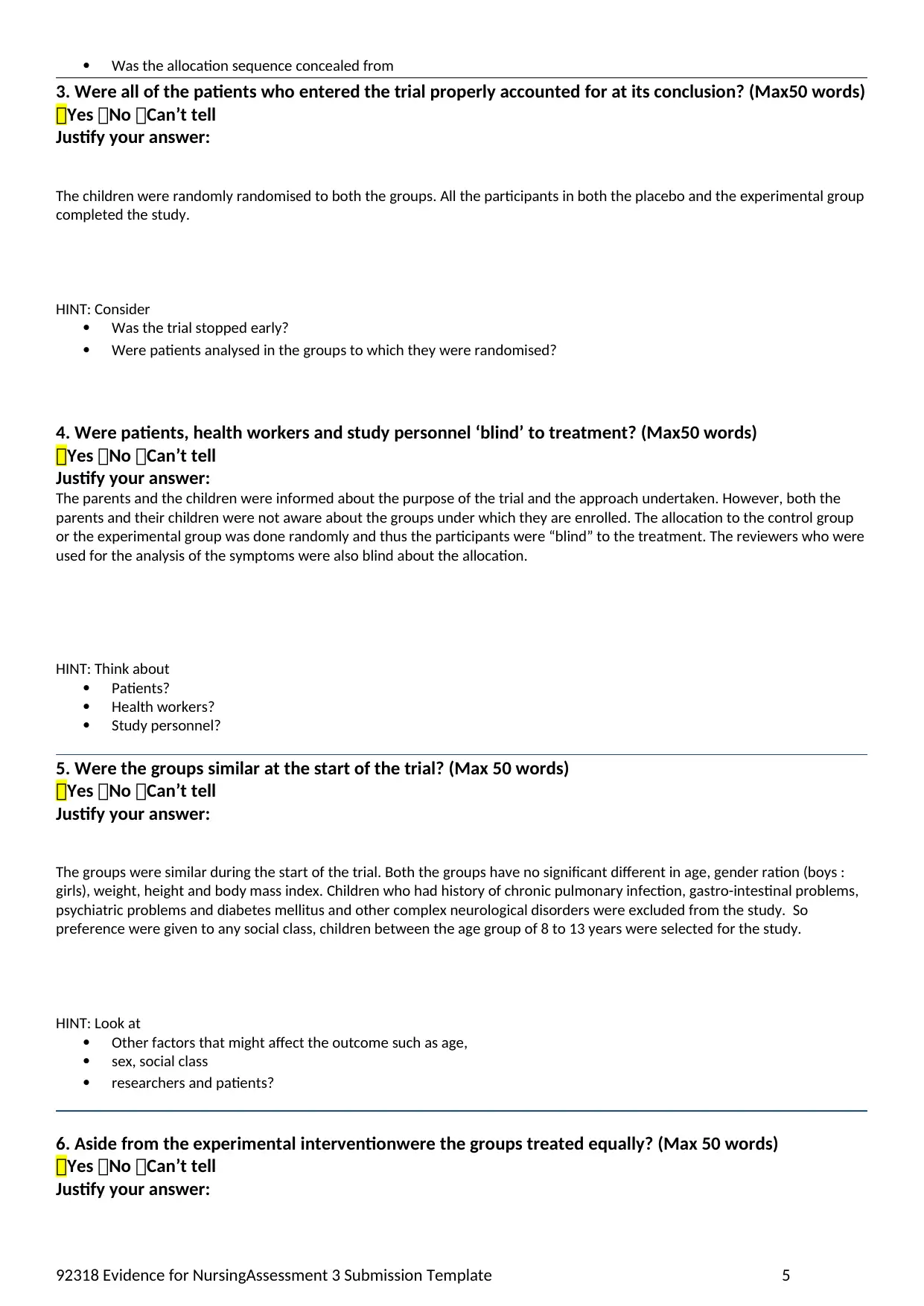
Was the allocation sequence concealed from
3. Were all of the patients who entered the trial properly accounted for at its conclusion? (Max50 words)
Yes No Can’t tell
Justify your answer:
The children were randomly randomised to both the groups. All the participants in both the placebo and the experimental group
completed the study.
HINT: Consider
Was the trial stopped early?
Were patients analysed in the groups to which they were randomised?
4. Were patients, health workers and study personnel ‘blind’ to treatment? (Max50 words)
Yes No Can’t tell
Justify your answer:
The parents and the children were informed about the purpose of the trial and the approach undertaken. However, both the
parents and their children were not aware about the groups under which they are enrolled. The allocation to the control group
or the experimental group was done randomly and thus the participants were “blind” to the treatment. The reviewers who were
used for the analysis of the symptoms were also blind about the allocation.
HINT: Think about
Patients?
Health workers?
Study personnel?
5. Were the groups similar at the start of the trial? (Max 50 words)
Yes No Can’t tell
Justify your answer:
The groups were similar during the start of the trial. Both the groups have no significant different in age, gender ration (boys :
girls), weight, height and body mass index. Children who had history of chronic pulmonary infection, gastro-intestinal problems,
psychiatric problems and diabetes mellitus and other complex neurological disorders were excluded from the study. So
preference were given to any social class, children between the age group of 8 to 13 years were selected for the study.
HINT: Look at
Other factors that might affect the outcome such as age,
sex, social class
researchers and patients?
6. Aside from the experimental interventionwere the groups treated equally? (Max 50 words)
Yes No Can’t tell
Justify your answer:
92318 Evidence for NursingAssessment 3 Submission Template 5
3. Were all of the patients who entered the trial properly accounted for at its conclusion? (Max50 words)
Yes No Can’t tell
Justify your answer:
The children were randomly randomised to both the groups. All the participants in both the placebo and the experimental group
completed the study.
HINT: Consider
Was the trial stopped early?
Were patients analysed in the groups to which they were randomised?
4. Were patients, health workers and study personnel ‘blind’ to treatment? (Max50 words)
Yes No Can’t tell
Justify your answer:
The parents and the children were informed about the purpose of the trial and the approach undertaken. However, both the
parents and their children were not aware about the groups under which they are enrolled. The allocation to the control group
or the experimental group was done randomly and thus the participants were “blind” to the treatment. The reviewers who were
used for the analysis of the symptoms were also blind about the allocation.
HINT: Think about
Patients?
Health workers?
Study personnel?
5. Were the groups similar at the start of the trial? (Max 50 words)
Yes No Can’t tell
Justify your answer:
The groups were similar during the start of the trial. Both the groups have no significant different in age, gender ration (boys :
girls), weight, height and body mass index. Children who had history of chronic pulmonary infection, gastro-intestinal problems,
psychiatric problems and diabetes mellitus and other complex neurological disorders were excluded from the study. So
preference were given to any social class, children between the age group of 8 to 13 years were selected for the study.
HINT: Look at
Other factors that might affect the outcome such as age,
sex, social class
researchers and patients?
6. Aside from the experimental interventionwere the groups treated equally? (Max 50 words)
Yes No Can’t tell
Justify your answer:
92318 Evidence for NursingAssessment 3 Submission Template 5
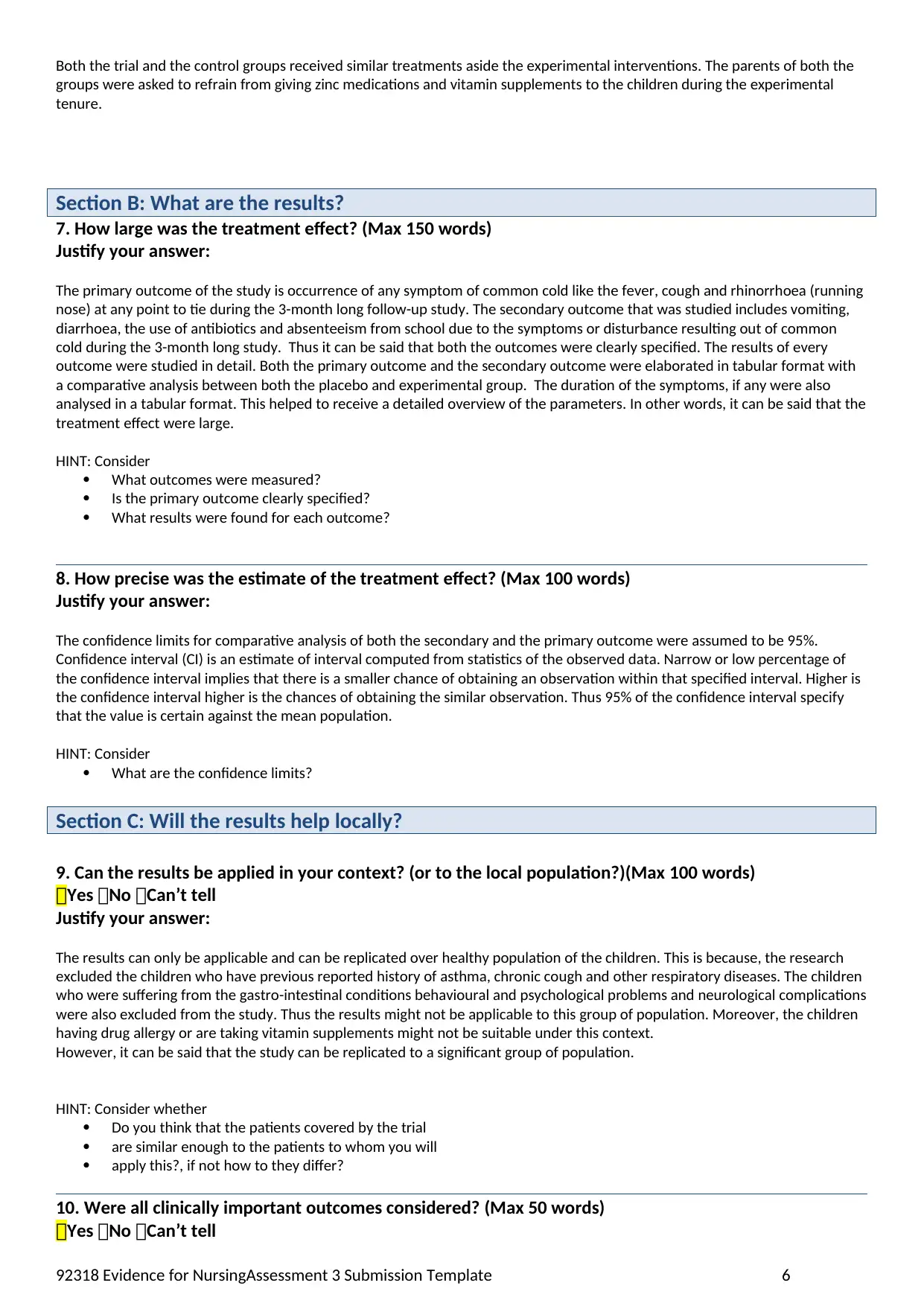
Both the trial and the control groups received similar treatments aside the experimental interventions. The parents of both the
groups were asked to refrain from giving zinc medications and vitamin supplements to the children during the experimental
tenure.
Section B: What are the results?
7. How large was the treatment effect? (Max 150 words)
Justify your answer:
The primary outcome of the study is occurrence of any symptom of common cold like the fever, cough and rhinorrhoea (running
nose) at any point to tie during the 3-month long follow-up study. The secondary outcome that was studied includes vomiting,
diarrhoea, the use of antibiotics and absenteeism from school due to the symptoms or disturbance resulting out of common
cold during the 3-month long study. Thus it can be said that both the outcomes were clearly specified. The results of every
outcome were studied in detail. Both the primary outcome and the secondary outcome were elaborated in tabular format with
a comparative analysis between both the placebo and experimental group. The duration of the symptoms, if any were also
analysed in a tabular format. This helped to receive a detailed overview of the parameters. In other words, it can be said that the
treatment effect were large.
HINT: Consider
What outcomes were measured?
Is the primary outcome clearly specified?
What results were found for each outcome?
8. How precise was the estimate of the treatment effect? (Max 100 words)
Justify your answer:
The confidence limits for comparative analysis of both the secondary and the primary outcome were assumed to be 95%.
Confidence interval (CI) is an estimate of interval computed from statistics of the observed data. Narrow or low percentage of
the confidence interval implies that there is a smaller chance of obtaining an observation within that specified interval. Higher is
the confidence interval higher is the chances of obtaining the similar observation. Thus 95% of the confidence interval specify
that the value is certain against the mean population.
HINT: Consider
What are the confidence limits?
Section C: Will the results help locally?
9. Can the results be applied in your context? (or to the local population?)(Max 100 words)
Yes No Can’t tell
Justify your answer:
The results can only be applicable and can be replicated over healthy population of the children. This is because, the research
excluded the children who have previous reported history of asthma, chronic cough and other respiratory diseases. The children
who were suffering from the gastro-intestinal conditions behavioural and psychological problems and neurological complications
were also excluded from the study. Thus the results might not be applicable to this group of population. Moreover, the children
having drug allergy or are taking vitamin supplements might not be suitable under this context.
However, it can be said that the study can be replicated to a significant group of population.
HINT: Consider whether
Do you think that the patients covered by the trial
are similar enough to the patients to whom you will
apply this?, if not how to they differ?
10. Were all clinically important outcomes considered? (Max 50 words)
Yes No Can’t tell
92318 Evidence for NursingAssessment 3 Submission Template 6
groups were asked to refrain from giving zinc medications and vitamin supplements to the children during the experimental
tenure.
Section B: What are the results?
7. How large was the treatment effect? (Max 150 words)
Justify your answer:
The primary outcome of the study is occurrence of any symptom of common cold like the fever, cough and rhinorrhoea (running
nose) at any point to tie during the 3-month long follow-up study. The secondary outcome that was studied includes vomiting,
diarrhoea, the use of antibiotics and absenteeism from school due to the symptoms or disturbance resulting out of common
cold during the 3-month long study. Thus it can be said that both the outcomes were clearly specified. The results of every
outcome were studied in detail. Both the primary outcome and the secondary outcome were elaborated in tabular format with
a comparative analysis between both the placebo and experimental group. The duration of the symptoms, if any were also
analysed in a tabular format. This helped to receive a detailed overview of the parameters. In other words, it can be said that the
treatment effect were large.
HINT: Consider
What outcomes were measured?
Is the primary outcome clearly specified?
What results were found for each outcome?
8. How precise was the estimate of the treatment effect? (Max 100 words)
Justify your answer:
The confidence limits for comparative analysis of both the secondary and the primary outcome were assumed to be 95%.
Confidence interval (CI) is an estimate of interval computed from statistics of the observed data. Narrow or low percentage of
the confidence interval implies that there is a smaller chance of obtaining an observation within that specified interval. Higher is
the confidence interval higher is the chances of obtaining the similar observation. Thus 95% of the confidence interval specify
that the value is certain against the mean population.
HINT: Consider
What are the confidence limits?
Section C: Will the results help locally?
9. Can the results be applied in your context? (or to the local population?)(Max 100 words)
Yes No Can’t tell
Justify your answer:
The results can only be applicable and can be replicated over healthy population of the children. This is because, the research
excluded the children who have previous reported history of asthma, chronic cough and other respiratory diseases. The children
who were suffering from the gastro-intestinal conditions behavioural and psychological problems and neurological complications
were also excluded from the study. Thus the results might not be applicable to this group of population. Moreover, the children
having drug allergy or are taking vitamin supplements might not be suitable under this context.
However, it can be said that the study can be replicated to a significant group of population.
HINT: Consider whether
Do you think that the patients covered by the trial
are similar enough to the patients to whom you will
apply this?, if not how to they differ?
10. Were all clinically important outcomes considered? (Max 50 words)
Yes No Can’t tell
92318 Evidence for NursingAssessment 3 Submission Template 6
⊘ This is a preview!⊘
Do you want full access?
Subscribe today to unlock all pages.

Trusted by 1+ million students worldwide
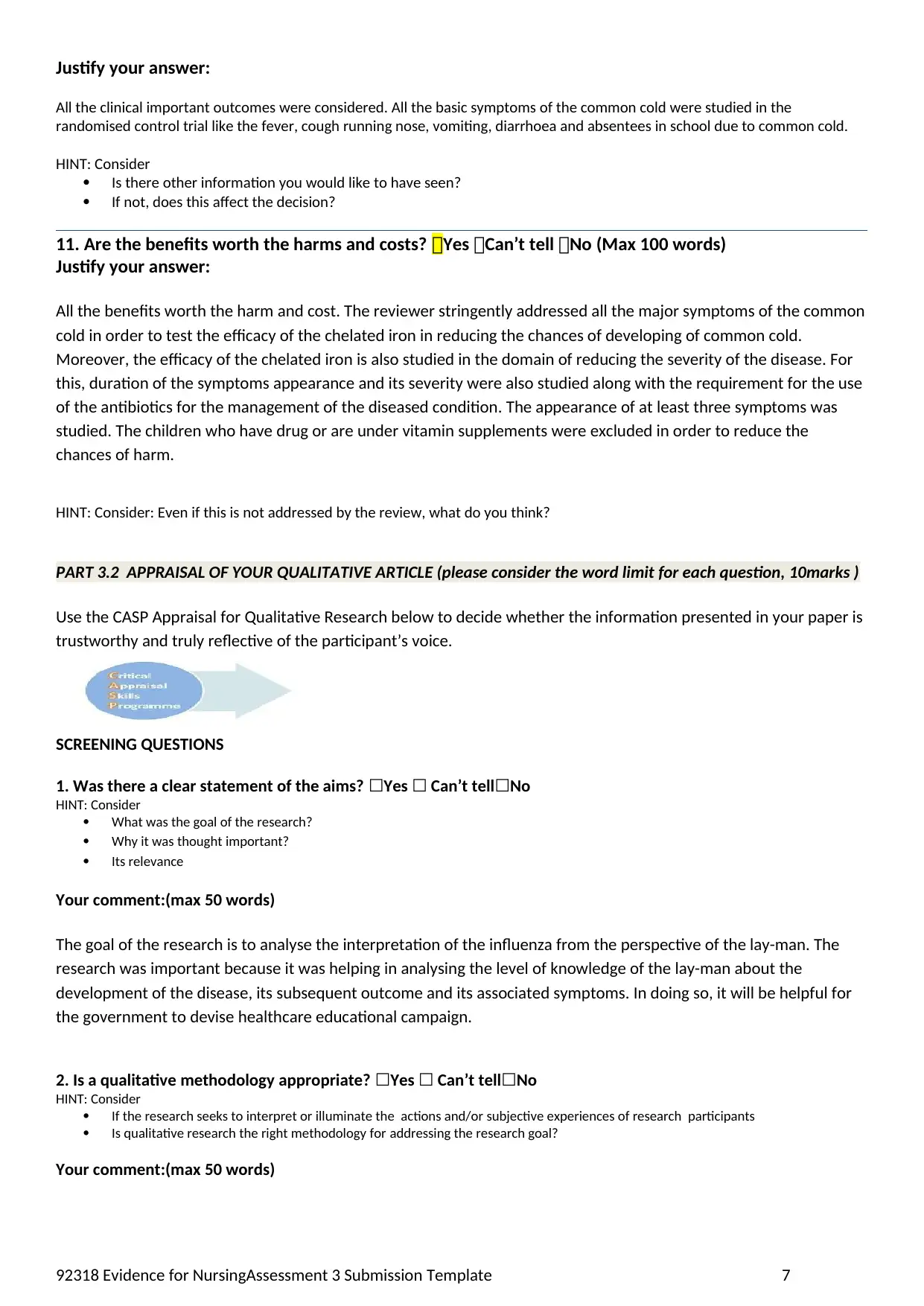
Justify your answer:
All the clinical important outcomes were considered. All the basic symptoms of the common cold were studied in the
randomised control trial like the fever, cough running nose, vomiting, diarrhoea and absentees in school due to common cold.
HINT: Consider
Is there other information you would like to have seen?
If not, does this affect the decision?
11. Are the benefits worth the harms and costs? Yes Can’t tell No (Max 100 words)
Justify your answer:
All the benefits worth the harm and cost. The reviewer stringently addressed all the major symptoms of the common
cold in order to test the efficacy of the chelated iron in reducing the chances of developing of common cold.
Moreover, the efficacy of the chelated iron is also studied in the domain of reducing the severity of the disease. For
this, duration of the symptoms appearance and its severity were also studied along with the requirement for the use
of the antibiotics for the management of the diseased condition. The appearance of at least three symptoms was
studied. The children who have drug or are under vitamin supplements were excluded in order to reduce the
chances of harm.
HINT: Consider: Even if this is not addressed by the review, what do you think?
PART 3.2 APPRAISAL OF YOUR QUALITATIVE ARTICLE (please consider the word limit for each question, 10marks )
Use the CASP Appraisal for Qualitative Research below to decide whether the information presented in your paper is
trustworthy and truly reflective of the participant’s voice.
SCREENING QUESTIONS
1. Was there a clear statement of the aims? ☐Yes ☐ Can’t tell☐No
HINT: Consider
What was the goal of the research?
Why it was thought important?
Its relevance
Your comment:(max 50 words)
The goal of the research is to analyse the interpretation of the influenza from the perspective of the lay-man. The
research was important because it was helping in analysing the level of knowledge of the lay-man about the
development of the disease, its subsequent outcome and its associated symptoms. In doing so, it will be helpful for
the government to devise healthcare educational campaign.
2. Is a qualitative methodology appropriate? ☐Yes ☐ Can’t tell☐No
HINT: Consider
If the research seeks to interpret or illuminate the actions and/or subjective experiences of research participants
Is qualitative research the right methodology for addressing the research goal?
Your comment:(max 50 words)
92318 Evidence for NursingAssessment 3 Submission Template 7
All the clinical important outcomes were considered. All the basic symptoms of the common cold were studied in the
randomised control trial like the fever, cough running nose, vomiting, diarrhoea and absentees in school due to common cold.
HINT: Consider
Is there other information you would like to have seen?
If not, does this affect the decision?
11. Are the benefits worth the harms and costs? Yes Can’t tell No (Max 100 words)
Justify your answer:
All the benefits worth the harm and cost. The reviewer stringently addressed all the major symptoms of the common
cold in order to test the efficacy of the chelated iron in reducing the chances of developing of common cold.
Moreover, the efficacy of the chelated iron is also studied in the domain of reducing the severity of the disease. For
this, duration of the symptoms appearance and its severity were also studied along with the requirement for the use
of the antibiotics for the management of the diseased condition. The appearance of at least three symptoms was
studied. The children who have drug or are under vitamin supplements were excluded in order to reduce the
chances of harm.
HINT: Consider: Even if this is not addressed by the review, what do you think?
PART 3.2 APPRAISAL OF YOUR QUALITATIVE ARTICLE (please consider the word limit for each question, 10marks )
Use the CASP Appraisal for Qualitative Research below to decide whether the information presented in your paper is
trustworthy and truly reflective of the participant’s voice.
SCREENING QUESTIONS
1. Was there a clear statement of the aims? ☐Yes ☐ Can’t tell☐No
HINT: Consider
What was the goal of the research?
Why it was thought important?
Its relevance
Your comment:(max 50 words)
The goal of the research is to analyse the interpretation of the influenza from the perspective of the lay-man. The
research was important because it was helping in analysing the level of knowledge of the lay-man about the
development of the disease, its subsequent outcome and its associated symptoms. In doing so, it will be helpful for
the government to devise healthcare educational campaign.
2. Is a qualitative methodology appropriate? ☐Yes ☐ Can’t tell☐No
HINT: Consider
If the research seeks to interpret or illuminate the actions and/or subjective experiences of research participants
Is qualitative research the right methodology for addressing the research goal?
Your comment:(max 50 words)
92318 Evidence for NursingAssessment 3 Submission Template 7
Paraphrase This Document
Need a fresh take? Get an instant paraphrase of this document with our AI Paraphraser
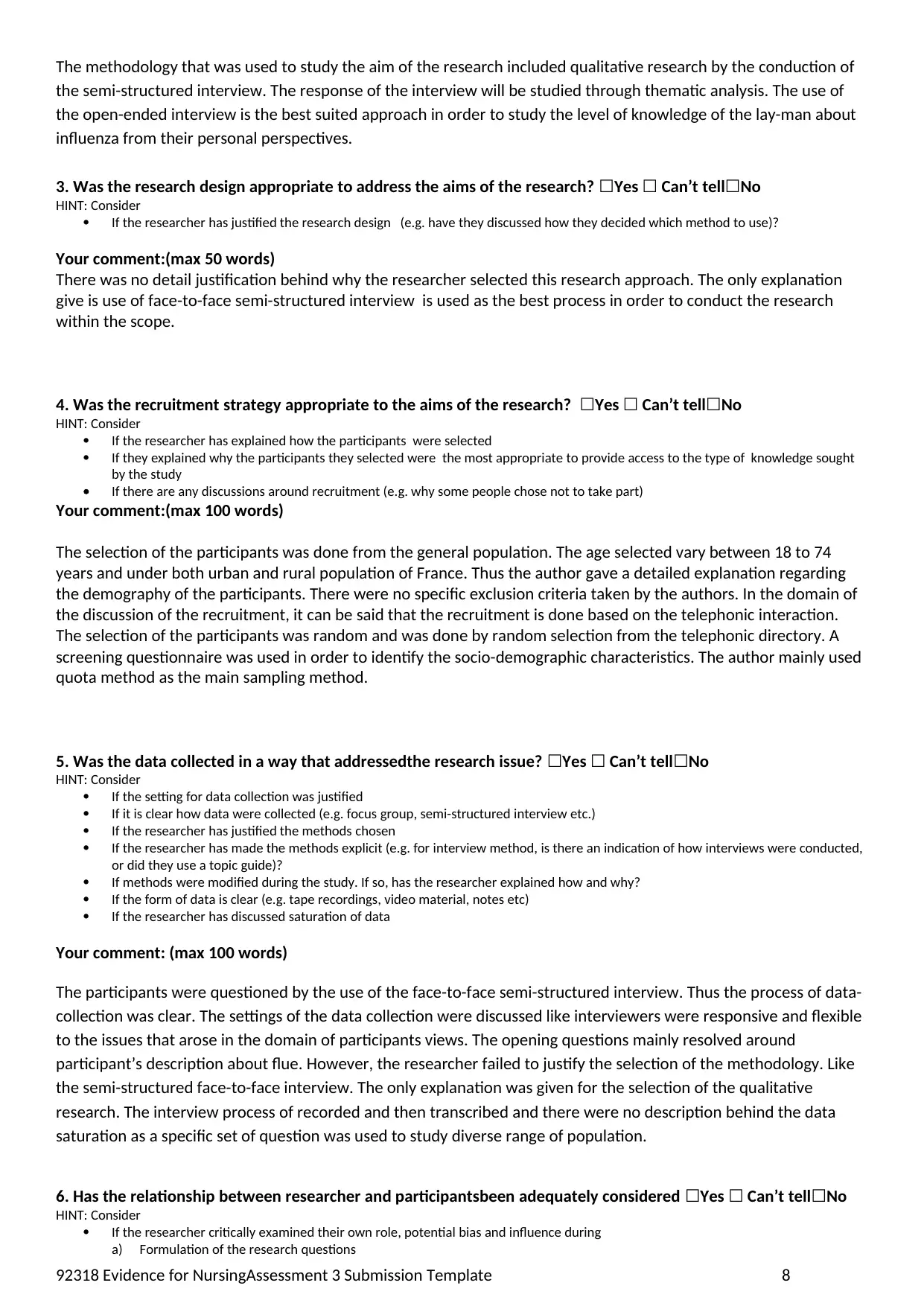
The methodology that was used to study the aim of the research included qualitative research by the conduction of
the semi-structured interview. The response of the interview will be studied through thematic analysis. The use of
the open-ended interview is the best suited approach in order to study the level of knowledge of the lay-man about
influenza from their personal perspectives.
3. Was the research design appropriate to address the aims of the research? ☐Yes ☐ Can’t tell☐No
HINT: Consider
If the researcher has justified the research design (e.g. have they discussed how they decided which method to use)?
Your comment:(max 50 words)
There was no detail justification behind why the researcher selected this research approach. The only explanation
give is use of face-to-face semi-structured interview is used as the best process in order to conduct the research
within the scope.
4. Was the recruitment strategy appropriate to the aims of the research? ☐Yes ☐ Can’t tell☐No
HINT: Consider
If the researcher has explained how the participants were selected
If they explained why the participants they selected were the most appropriate to provide access to the type of knowledge sought
by the study
If there are any discussions around recruitment (e.g. why some people chose not to take part)
Your comment:(max 100 words)
The selection of the participants was done from the general population. The age selected vary between 18 to 74
years and under both urban and rural population of France. Thus the author gave a detailed explanation regarding
the demography of the participants. There were no specific exclusion criteria taken by the authors. In the domain of
the discussion of the recruitment, it can be said that the recruitment is done based on the telephonic interaction.
The selection of the participants was random and was done by random selection from the telephonic directory. A
screening questionnaire was used in order to identify the socio-demographic characteristics. The author mainly used
quota method as the main sampling method.
5. Was the data collected in a way that addressedthe research issue? ☐Yes ☐ Can’t tell☐No
HINT: Consider
If the setting for data collection was justified
If it is clear how data were collected (e.g. focus group, semi-structured interview etc.)
If the researcher has justified the methods chosen
If the researcher has made the methods explicit (e.g. for interview method, is there an indication of how interviews were conducted,
or did they use a topic guide)?
If methods were modified during the study. If so, has the researcher explained how and why?
If the form of data is clear (e.g. tape recordings, video material, notes etc)
If the researcher has discussed saturation of data
Your comment: (max 100 words)
The participants were questioned by the use of the face-to-face semi-structured interview. Thus the process of data-
collection was clear. The settings of the data collection were discussed like interviewers were responsive and flexible
to the issues that arose in the domain of participants views. The opening questions mainly resolved around
participant’s description about flue. However, the researcher failed to justify the selection of the methodology. Like
the semi-structured face-to-face interview. The only explanation was given for the selection of the qualitative
research. The interview process of recorded and then transcribed and there were no description behind the data
saturation as a specific set of question was used to study diverse range of population.
6. Has the relationship between researcher and participantsbeen adequately considered ☐Yes ☐ Can’t tell☐No
HINT: Consider
If the researcher critically examined their own role, potential bias and influence during
a) Formulation of the research questions
92318 Evidence for NursingAssessment 3 Submission Template 8
the semi-structured interview. The response of the interview will be studied through thematic analysis. The use of
the open-ended interview is the best suited approach in order to study the level of knowledge of the lay-man about
influenza from their personal perspectives.
3. Was the research design appropriate to address the aims of the research? ☐Yes ☐ Can’t tell☐No
HINT: Consider
If the researcher has justified the research design (e.g. have they discussed how they decided which method to use)?
Your comment:(max 50 words)
There was no detail justification behind why the researcher selected this research approach. The only explanation
give is use of face-to-face semi-structured interview is used as the best process in order to conduct the research
within the scope.
4. Was the recruitment strategy appropriate to the aims of the research? ☐Yes ☐ Can’t tell☐No
HINT: Consider
If the researcher has explained how the participants were selected
If they explained why the participants they selected were the most appropriate to provide access to the type of knowledge sought
by the study
If there are any discussions around recruitment (e.g. why some people chose not to take part)
Your comment:(max 100 words)
The selection of the participants was done from the general population. The age selected vary between 18 to 74
years and under both urban and rural population of France. Thus the author gave a detailed explanation regarding
the demography of the participants. There were no specific exclusion criteria taken by the authors. In the domain of
the discussion of the recruitment, it can be said that the recruitment is done based on the telephonic interaction.
The selection of the participants was random and was done by random selection from the telephonic directory. A
screening questionnaire was used in order to identify the socio-demographic characteristics. The author mainly used
quota method as the main sampling method.
5. Was the data collected in a way that addressedthe research issue? ☐Yes ☐ Can’t tell☐No
HINT: Consider
If the setting for data collection was justified
If it is clear how data were collected (e.g. focus group, semi-structured interview etc.)
If the researcher has justified the methods chosen
If the researcher has made the methods explicit (e.g. for interview method, is there an indication of how interviews were conducted,
or did they use a topic guide)?
If methods were modified during the study. If so, has the researcher explained how and why?
If the form of data is clear (e.g. tape recordings, video material, notes etc)
If the researcher has discussed saturation of data
Your comment: (max 100 words)
The participants were questioned by the use of the face-to-face semi-structured interview. Thus the process of data-
collection was clear. The settings of the data collection were discussed like interviewers were responsive and flexible
to the issues that arose in the domain of participants views. The opening questions mainly resolved around
participant’s description about flue. However, the researcher failed to justify the selection of the methodology. Like
the semi-structured face-to-face interview. The only explanation was given for the selection of the qualitative
research. The interview process of recorded and then transcribed and there were no description behind the data
saturation as a specific set of question was used to study diverse range of population.
6. Has the relationship between researcher and participantsbeen adequately considered ☐Yes ☐ Can’t tell☐No
HINT: Consider
If the researcher critically examined their own role, potential bias and influence during
a) Formulation of the research questions
92318 Evidence for NursingAssessment 3 Submission Template 8
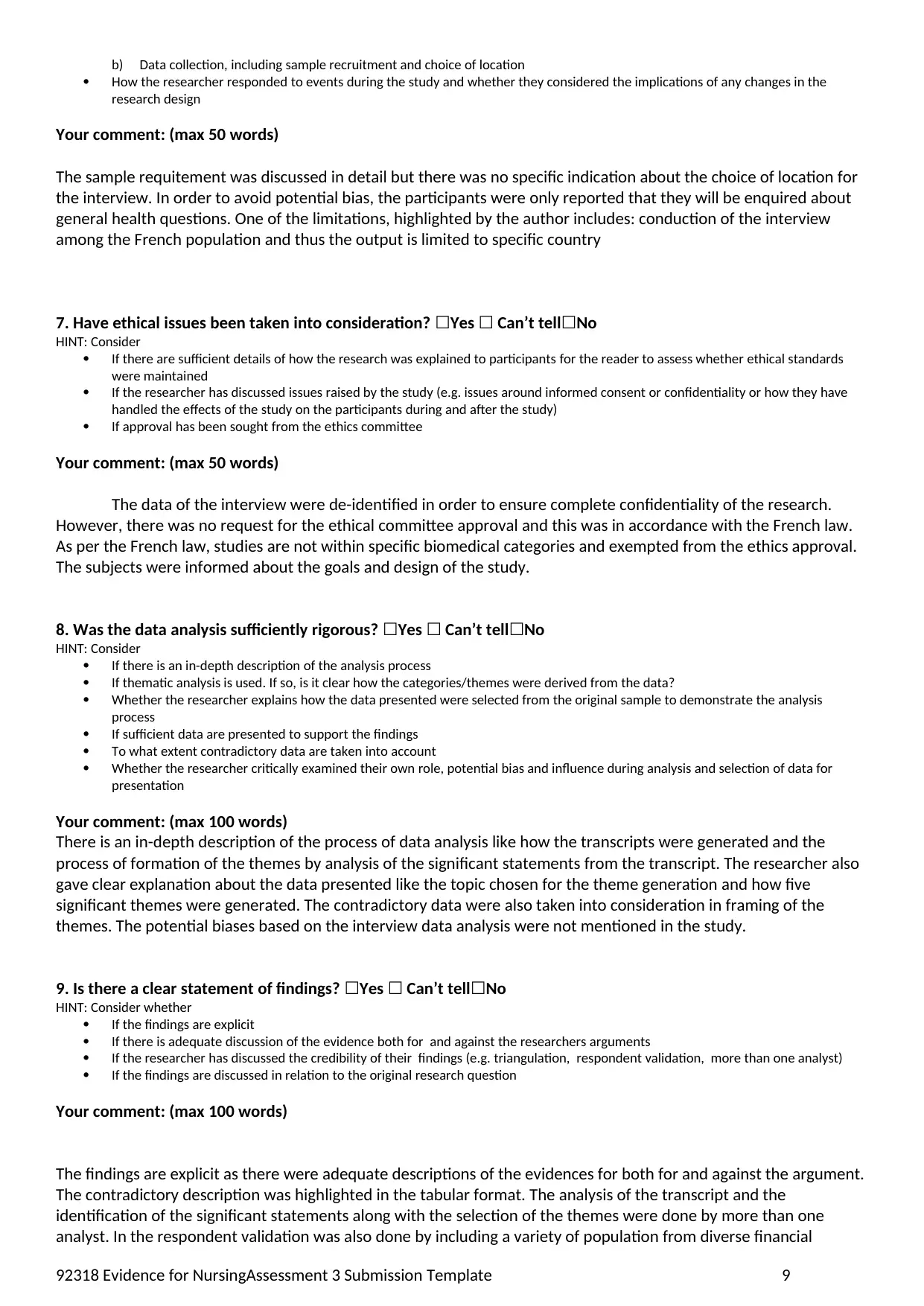
b) Data collection, including sample recruitment and choice of location
How the researcher responded to events during the study and whether they considered the implications of any changes in the
research design
Your comment: (max 50 words)
The sample requitement was discussed in detail but there was no specific indication about the choice of location for
the interview. In order to avoid potential bias, the participants were only reported that they will be enquired about
general health questions. One of the limitations, highlighted by the author includes: conduction of the interview
among the French population and thus the output is limited to specific country
7. Have ethical issues been taken into consideration? ☐Yes ☐ Can’t tell☐No
HINT: Consider
If there are sufficient details of how the research was explained to participants for the reader to assess whether ethical standards
were maintained
If the researcher has discussed issues raised by the study (e.g. issues around informed consent or confidentiality or how they have
handled the effects of the study on the participants during and after the study)
If approval has been sought from the ethics committee
Your comment: (max 50 words)
The data of the interview were de-identified in order to ensure complete confidentiality of the research.
However, there was no request for the ethical committee approval and this was in accordance with the French law.
As per the French law, studies are not within specific biomedical categories and exempted from the ethics approval.
The subjects were informed about the goals and design of the study.
8. Was the data analysis sufficiently rigorous? ☐Yes ☐ Can’t tell☐No
HINT: Consider
If there is an in-depth description of the analysis process
If thematic analysis is used. If so, is it clear how the categories/themes were derived from the data?
Whether the researcher explains how the data presented were selected from the original sample to demonstrate the analysis
process
If sufficient data are presented to support the findings
To what extent contradictory data are taken into account
Whether the researcher critically examined their own role, potential bias and influence during analysis and selection of data for
presentation
Your comment: (max 100 words)
There is an in-depth description of the process of data analysis like how the transcripts were generated and the
process of formation of the themes by analysis of the significant statements from the transcript. The researcher also
gave clear explanation about the data presented like the topic chosen for the theme generation and how five
significant themes were generated. The contradictory data were also taken into consideration in framing of the
themes. The potential biases based on the interview data analysis were not mentioned in the study.
9. Is there a clear statement of findings? ☐Yes ☐ Can’t tell☐No
HINT: Consider whether
If the findings are explicit
If there is adequate discussion of the evidence both for and against the researchers arguments
If the researcher has discussed the credibility of their findings (e.g. triangulation, respondent validation, more than one analyst)
If the findings are discussed in relation to the original research question
Your comment: (max 100 words)
The findings are explicit as there were adequate descriptions of the evidences for both for and against the argument.
The contradictory description was highlighted in the tabular format. The analysis of the transcript and the
identification of the significant statements along with the selection of the themes were done by more than one
analyst. In the respondent validation was also done by including a variety of population from diverse financial
92318 Evidence for NursingAssessment 3 Submission Template 9
How the researcher responded to events during the study and whether they considered the implications of any changes in the
research design
Your comment: (max 50 words)
The sample requitement was discussed in detail but there was no specific indication about the choice of location for
the interview. In order to avoid potential bias, the participants were only reported that they will be enquired about
general health questions. One of the limitations, highlighted by the author includes: conduction of the interview
among the French population and thus the output is limited to specific country
7. Have ethical issues been taken into consideration? ☐Yes ☐ Can’t tell☐No
HINT: Consider
If there are sufficient details of how the research was explained to participants for the reader to assess whether ethical standards
were maintained
If the researcher has discussed issues raised by the study (e.g. issues around informed consent or confidentiality or how they have
handled the effects of the study on the participants during and after the study)
If approval has been sought from the ethics committee
Your comment: (max 50 words)
The data of the interview were de-identified in order to ensure complete confidentiality of the research.
However, there was no request for the ethical committee approval and this was in accordance with the French law.
As per the French law, studies are not within specific biomedical categories and exempted from the ethics approval.
The subjects were informed about the goals and design of the study.
8. Was the data analysis sufficiently rigorous? ☐Yes ☐ Can’t tell☐No
HINT: Consider
If there is an in-depth description of the analysis process
If thematic analysis is used. If so, is it clear how the categories/themes were derived from the data?
Whether the researcher explains how the data presented were selected from the original sample to demonstrate the analysis
process
If sufficient data are presented to support the findings
To what extent contradictory data are taken into account
Whether the researcher critically examined their own role, potential bias and influence during analysis and selection of data for
presentation
Your comment: (max 100 words)
There is an in-depth description of the process of data analysis like how the transcripts were generated and the
process of formation of the themes by analysis of the significant statements from the transcript. The researcher also
gave clear explanation about the data presented like the topic chosen for the theme generation and how five
significant themes were generated. The contradictory data were also taken into consideration in framing of the
themes. The potential biases based on the interview data analysis were not mentioned in the study.
9. Is there a clear statement of findings? ☐Yes ☐ Can’t tell☐No
HINT: Consider whether
If the findings are explicit
If there is adequate discussion of the evidence both for and against the researchers arguments
If the researcher has discussed the credibility of their findings (e.g. triangulation, respondent validation, more than one analyst)
If the findings are discussed in relation to the original research question
Your comment: (max 100 words)
The findings are explicit as there were adequate descriptions of the evidences for both for and against the argument.
The contradictory description was highlighted in the tabular format. The analysis of the transcript and the
identification of the significant statements along with the selection of the themes were done by more than one
analyst. In the respondent validation was also done by including a variety of population from diverse financial
92318 Evidence for NursingAssessment 3 Submission Template 9
⊘ This is a preview!⊘
Do you want full access?
Subscribe today to unlock all pages.

Trusted by 1+ million students worldwide
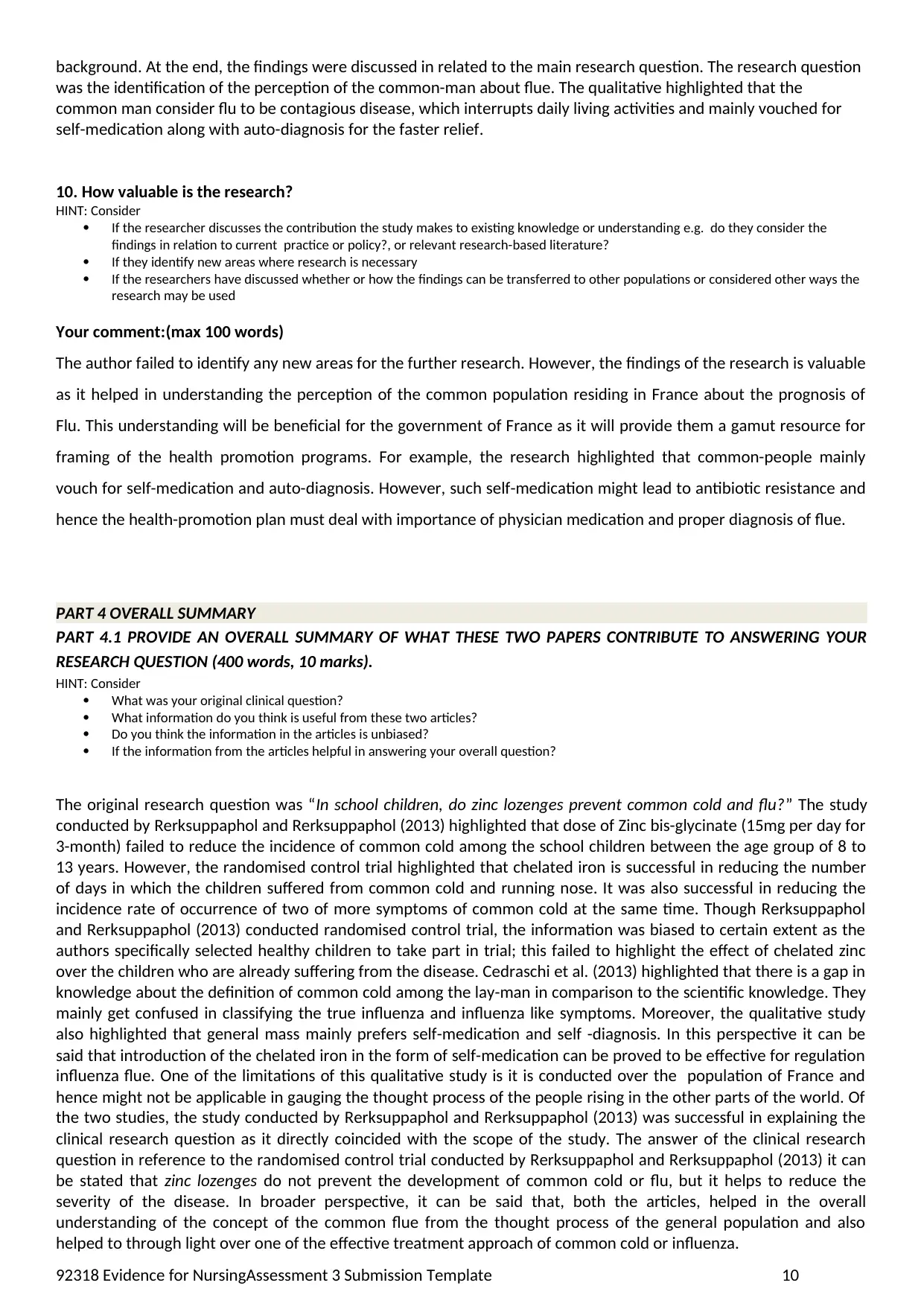
background. At the end, the findings were discussed in related to the main research question. The research question
was the identification of the perception of the common-man about flue. The qualitative highlighted that the
common man consider flu to be contagious disease, which interrupts daily living activities and mainly vouched for
self-medication along with auto-diagnosis for the faster relief.
10. How valuable is the research?
HINT: Consider
If the researcher discusses the contribution the study makes to existing knowledge or understanding e.g. do they consider the
findings in relation to current practice or policy?, or relevant research-based literature?
If they identify new areas where research is necessary
If the researchers have discussed whether or how the findings can be transferred to other populations or considered other ways the
research may be used
Your comment:(max 100 words)
The author failed to identify any new areas for the further research. However, the findings of the research is valuable
as it helped in understanding the perception of the common population residing in France about the prognosis of
Flu. This understanding will be beneficial for the government of France as it will provide them a gamut resource for
framing of the health promotion programs. For example, the research highlighted that common-people mainly
vouch for self-medication and auto-diagnosis. However, such self-medication might lead to antibiotic resistance and
hence the health-promotion plan must deal with importance of physician medication and proper diagnosis of flue.
PART 4 OVERALL SUMMARY
PART 4.1 PROVIDE AN OVERALL SUMMARY OF WHAT THESE TWO PAPERS CONTRIBUTE TO ANSWERING YOUR
RESEARCH QUESTION (400 words, 10 marks).
HINT: Consider
What was your original clinical question?
What information do you think is useful from these two articles?
Do you think the information in the articles is unbiased?
If the information from the articles helpful in answering your overall question?
The original research question was “In school children, do zinc lozenges prevent common cold and flu?” The study
conducted by Rerksuppaphol and Rerksuppaphol (2013) highlighted that dose of Zinc bis-glycinate (15mg per day for
3-month) failed to reduce the incidence of common cold among the school children between the age group of 8 to
13 years. However, the randomised control trial highlighted that chelated iron is successful in reducing the number
of days in which the children suffered from common cold and running nose. It was also successful in reducing the
incidence rate of occurrence of two of more symptoms of common cold at the same time. Though Rerksuppaphol
and Rerksuppaphol (2013) conducted randomised control trial, the information was biased to certain extent as the
authors specifically selected healthy children to take part in trial; this failed to highlight the effect of chelated zinc
over the children who are already suffering from the disease. Cedraschi et al. (2013) highlighted that there is a gap in
knowledge about the definition of common cold among the lay-man in comparison to the scientific knowledge. They
mainly get confused in classifying the true influenza and influenza like symptoms. Moreover, the qualitative study
also highlighted that general mass mainly prefers self-medication and self -diagnosis. In this perspective it can be
said that introduction of the chelated iron in the form of self-medication can be proved to be effective for regulation
influenza flue. One of the limitations of this qualitative study is it is conducted over the population of France and
hence might not be applicable in gauging the thought process of the people rising in the other parts of the world. Of
the two studies, the study conducted by Rerksuppaphol and Rerksuppaphol (2013) was successful in explaining the
clinical research question as it directly coincided with the scope of the study. The answer of the clinical research
question in reference to the randomised control trial conducted by Rerksuppaphol and Rerksuppaphol (2013) it can
be stated that zinc lozenges do not prevent the development of common cold or flu, but it helps to reduce the
severity of the disease. In broader perspective, it can be said that, both the articles, helped in the overall
understanding of the concept of the common flue from the thought process of the general population and also
helped to through light over one of the effective treatment approach of common cold or influenza.
92318 Evidence for NursingAssessment 3 Submission Template 10
was the identification of the perception of the common-man about flue. The qualitative highlighted that the
common man consider flu to be contagious disease, which interrupts daily living activities and mainly vouched for
self-medication along with auto-diagnosis for the faster relief.
10. How valuable is the research?
HINT: Consider
If the researcher discusses the contribution the study makes to existing knowledge or understanding e.g. do they consider the
findings in relation to current practice or policy?, or relevant research-based literature?
If they identify new areas where research is necessary
If the researchers have discussed whether or how the findings can be transferred to other populations or considered other ways the
research may be used
Your comment:(max 100 words)
The author failed to identify any new areas for the further research. However, the findings of the research is valuable
as it helped in understanding the perception of the common population residing in France about the prognosis of
Flu. This understanding will be beneficial for the government of France as it will provide them a gamut resource for
framing of the health promotion programs. For example, the research highlighted that common-people mainly
vouch for self-medication and auto-diagnosis. However, such self-medication might lead to antibiotic resistance and
hence the health-promotion plan must deal with importance of physician medication and proper diagnosis of flue.
PART 4 OVERALL SUMMARY
PART 4.1 PROVIDE AN OVERALL SUMMARY OF WHAT THESE TWO PAPERS CONTRIBUTE TO ANSWERING YOUR
RESEARCH QUESTION (400 words, 10 marks).
HINT: Consider
What was your original clinical question?
What information do you think is useful from these two articles?
Do you think the information in the articles is unbiased?
If the information from the articles helpful in answering your overall question?
The original research question was “In school children, do zinc lozenges prevent common cold and flu?” The study
conducted by Rerksuppaphol and Rerksuppaphol (2013) highlighted that dose of Zinc bis-glycinate (15mg per day for
3-month) failed to reduce the incidence of common cold among the school children between the age group of 8 to
13 years. However, the randomised control trial highlighted that chelated iron is successful in reducing the number
of days in which the children suffered from common cold and running nose. It was also successful in reducing the
incidence rate of occurrence of two of more symptoms of common cold at the same time. Though Rerksuppaphol
and Rerksuppaphol (2013) conducted randomised control trial, the information was biased to certain extent as the
authors specifically selected healthy children to take part in trial; this failed to highlight the effect of chelated zinc
over the children who are already suffering from the disease. Cedraschi et al. (2013) highlighted that there is a gap in
knowledge about the definition of common cold among the lay-man in comparison to the scientific knowledge. They
mainly get confused in classifying the true influenza and influenza like symptoms. Moreover, the qualitative study
also highlighted that general mass mainly prefers self-medication and self -diagnosis. In this perspective it can be
said that introduction of the chelated iron in the form of self-medication can be proved to be effective for regulation
influenza flue. One of the limitations of this qualitative study is it is conducted over the population of France and
hence might not be applicable in gauging the thought process of the people rising in the other parts of the world. Of
the two studies, the study conducted by Rerksuppaphol and Rerksuppaphol (2013) was successful in explaining the
clinical research question as it directly coincided with the scope of the study. The answer of the clinical research
question in reference to the randomised control trial conducted by Rerksuppaphol and Rerksuppaphol (2013) it can
be stated that zinc lozenges do not prevent the development of common cold or flu, but it helps to reduce the
severity of the disease. In broader perspective, it can be said that, both the articles, helped in the overall
understanding of the concept of the common flue from the thought process of the general population and also
helped to through light over one of the effective treatment approach of common cold or influenza.
92318 Evidence for NursingAssessment 3 Submission Template 10
Paraphrase This Document
Need a fresh take? Get an instant paraphrase of this document with our AI Paraphraser
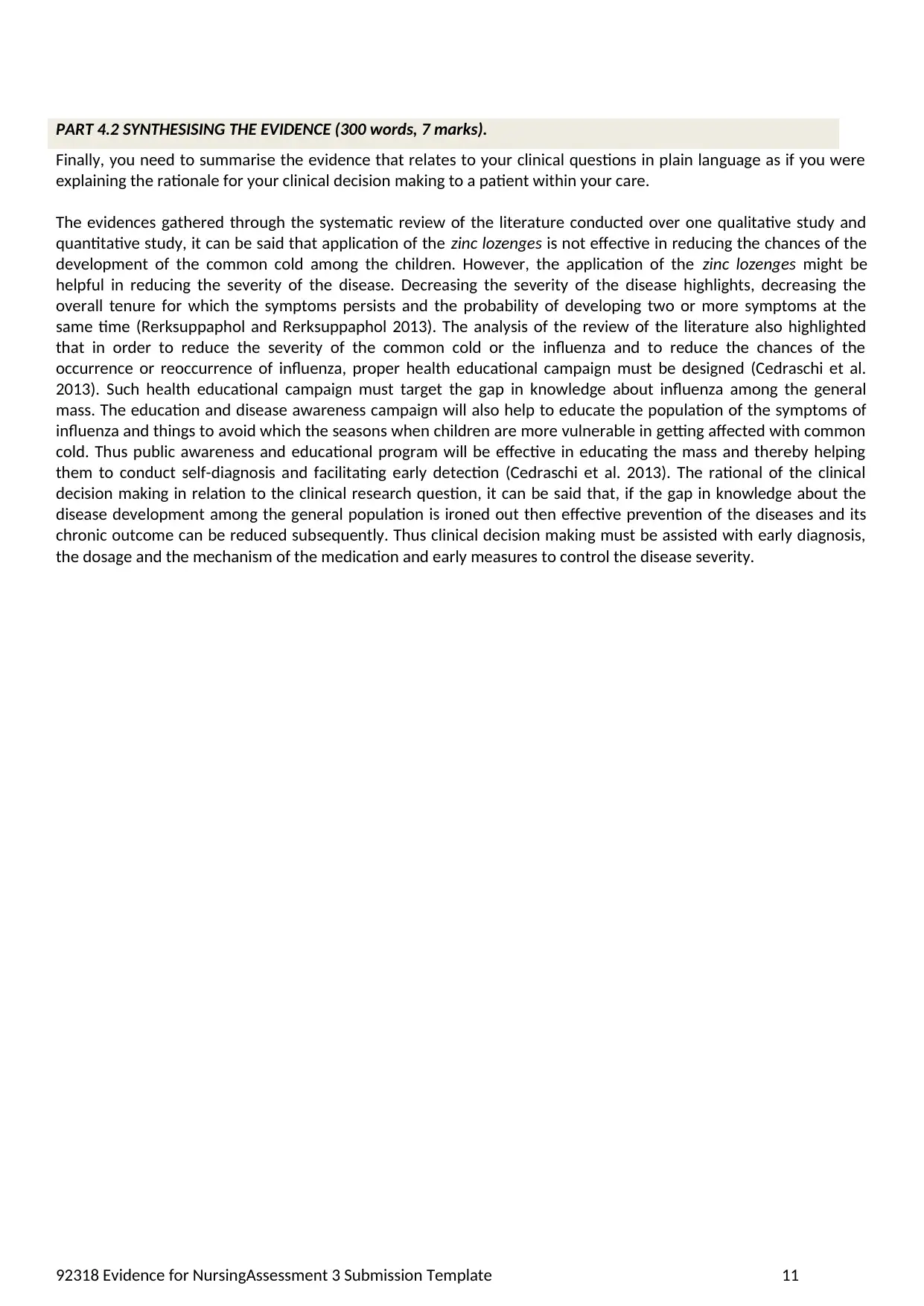
PART 4.2 SYNTHESISING THE EVIDENCE (300 words, 7 marks).
Finally, you need to summarise the evidence that relates to your clinical questions in plain language as if you were
explaining the rationale for your clinical decision making to a patient within your care.
The evidences gathered through the systematic review of the literature conducted over one qualitative study and
quantitative study, it can be said that application of the zinc lozenges is not effective in reducing the chances of the
development of the common cold among the children. However, the application of the zinc lozenges might be
helpful in reducing the severity of the disease. Decreasing the severity of the disease highlights, decreasing the
overall tenure for which the symptoms persists and the probability of developing two or more symptoms at the
same time (Rerksuppaphol and Rerksuppaphol 2013). The analysis of the review of the literature also highlighted
that in order to reduce the severity of the common cold or the influenza and to reduce the chances of the
occurrence or reoccurrence of influenza, proper health educational campaign must be designed (Cedraschi et al.
2013). Such health educational campaign must target the gap in knowledge about influenza among the general
mass. The education and disease awareness campaign will also help to educate the population of the symptoms of
influenza and things to avoid which the seasons when children are more vulnerable in getting affected with common
cold. Thus public awareness and educational program will be effective in educating the mass and thereby helping
them to conduct self-diagnosis and facilitating early detection (Cedraschi et al. 2013). The rational of the clinical
decision making in relation to the clinical research question, it can be said that, if the gap in knowledge about the
disease development among the general population is ironed out then effective prevention of the diseases and its
chronic outcome can be reduced subsequently. Thus clinical decision making must be assisted with early diagnosis,
the dosage and the mechanism of the medication and early measures to control the disease severity.
92318 Evidence for NursingAssessment 3 Submission Template 11
Finally, you need to summarise the evidence that relates to your clinical questions in plain language as if you were
explaining the rationale for your clinical decision making to a patient within your care.
The evidences gathered through the systematic review of the literature conducted over one qualitative study and
quantitative study, it can be said that application of the zinc lozenges is not effective in reducing the chances of the
development of the common cold among the children. However, the application of the zinc lozenges might be
helpful in reducing the severity of the disease. Decreasing the severity of the disease highlights, decreasing the
overall tenure for which the symptoms persists and the probability of developing two or more symptoms at the
same time (Rerksuppaphol and Rerksuppaphol 2013). The analysis of the review of the literature also highlighted
that in order to reduce the severity of the common cold or the influenza and to reduce the chances of the
occurrence or reoccurrence of influenza, proper health educational campaign must be designed (Cedraschi et al.
2013). Such health educational campaign must target the gap in knowledge about influenza among the general
mass. The education and disease awareness campaign will also help to educate the population of the symptoms of
influenza and things to avoid which the seasons when children are more vulnerable in getting affected with common
cold. Thus public awareness and educational program will be effective in educating the mass and thereby helping
them to conduct self-diagnosis and facilitating early detection (Cedraschi et al. 2013). The rational of the clinical
decision making in relation to the clinical research question, it can be said that, if the gap in knowledge about the
disease development among the general population is ironed out then effective prevention of the diseases and its
chronic outcome can be reduced subsequently. Thus clinical decision making must be assisted with early diagnosis,
the dosage and the mechanism of the medication and early measures to control the disease severity.
92318 Evidence for NursingAssessment 3 Submission Template 11
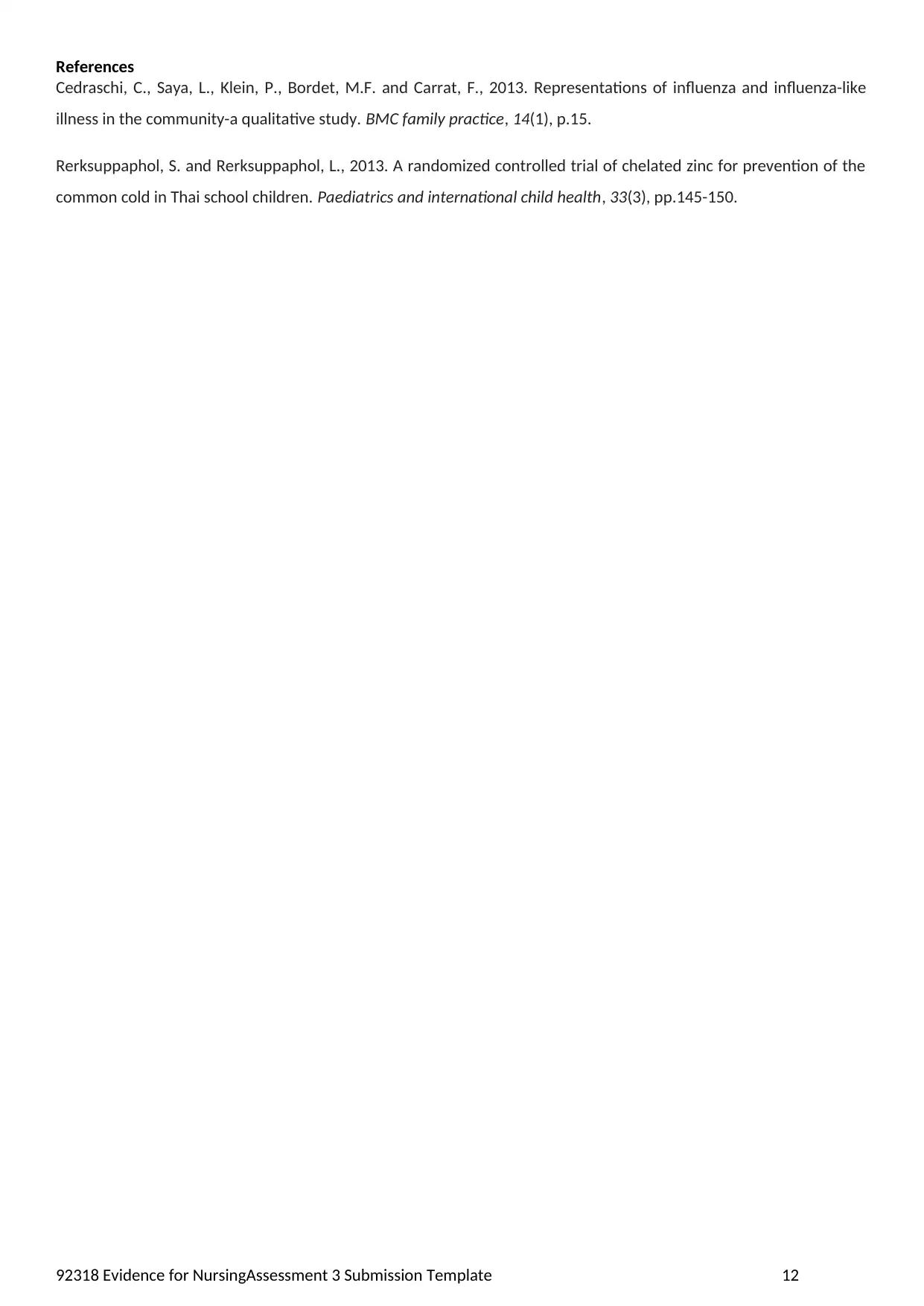
References
Cedraschi, C., Saya, L., Klein, P., Bordet, M.F. and Carrat, F., 2013. Representations of influenza and influenza-like
illness in the community-a qualitative study. BMC family practice, 14(1), p.15.
Rerksuppaphol, S. and Rerksuppaphol, L., 2013. A randomized controlled trial of chelated zinc for prevention of the
common cold in Thai school children. Paediatrics and international child health, 33(3), pp.145-150.
92318 Evidence for NursingAssessment 3 Submission Template 12
Cedraschi, C., Saya, L., Klein, P., Bordet, M.F. and Carrat, F., 2013. Representations of influenza and influenza-like
illness in the community-a qualitative study. BMC family practice, 14(1), p.15.
Rerksuppaphol, S. and Rerksuppaphol, L., 2013. A randomized controlled trial of chelated zinc for prevention of the
common cold in Thai school children. Paediatrics and international child health, 33(3), pp.145-150.
92318 Evidence for NursingAssessment 3 Submission Template 12
⊘ This is a preview!⊘
Do you want full access?
Subscribe today to unlock all pages.

Trusted by 1+ million students worldwide
1 out of 12
Related Documents
Your All-in-One AI-Powered Toolkit for Academic Success.
+13062052269
info@desklib.com
Available 24*7 on WhatsApp / Email
![[object Object]](/_next/static/media/star-bottom.7253800d.svg)
Unlock your academic potential
Copyright © 2020–2025 A2Z Services. All Rights Reserved. Developed and managed by ZUCOL.





